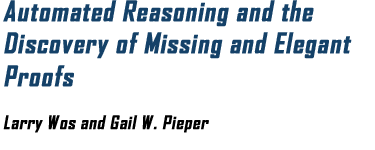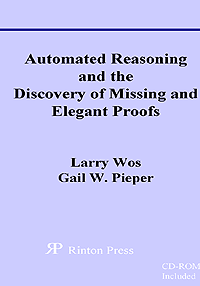| |

|
 |
|
 |
384 pages 10x7 inches w/
CDROM
December
2003 Hardcover
ISBN 1-58949-023-1
US$88 |
|
|
|
Buy It |
|
|
 
This book is rare -- perhaps the only one of its type --
in that it simultaneously provides the basis for diverse
courses in logic, mathematics, and automated reasoning;
teaches how research can be successfully conducted; and
presents results that had eluded various masters for
many decades. Key to obtaining these results is the use
of strategies and methodologies, detailed in this
volume, and the marvelous program OTTER (featured here)
-- which automates logical reasoning, deducing millions
of conclusions that follow inevitably from the
hypotheses supplied by the user. In this book, various
aspects of the newly discovered Hilbert's twenty-fourth
problem are addressed. The included CD-ROM offers OTTER
in various forms, numerous input files, and a large
number of proofs that are new. By experimenting with
these offerings, both the new researcher and the expert
alike may experience the excitement of attacking deep
open questions and discovering missing and elegant
proofs. |

Foreword
Preface
1 Challenge and Reward
1.1 Unwitting Foundation for Automation
1.2 The Arrival of Automated Reasoning
1.2.1 Representing Information, Language
1.2.2 Drawing Conclusions, Inference Rules
1.2.3 Controlling Reasoning, Strategy
2 Methodology, Strategy and a Significant Proof
2.1 Lemma Adjunction
2.2 Term Avoidance
2.3 The Role of Prior Knowledge
2.4 Proof Contraction
2.5 Three Short Proofs for the Lukasiewicz 23-Letter
Formula
3 Attacking Hilbert's Twenty-Fourth Problem
3.1 A Basis for Refinement Methodologies
3.2 A Tidy Approach for Abridging the Meredith Proof
3.3 A Most Intriguing Proof
3.4 Other Methodologies, Other Types of Refinement
4 Other Logics
4.1 Lukasiewicz's Infinite-valued Sentential Calculus
4.2 Equivalential Calculus
4.3 Revisiting Propositional Calculus
4.4 Modal Logic
4.5 Relevance Logic
4.6 Intuitionistic Logic
5 Equality
5.1 Group Theory
5.1.1 The Commutator-Normal Subgroup Problem
5.1.2 Single Axioms
5.1.3 Groups of Odd Exponent
5.1.4 Groups of Even Exponent
5.2 Lattice Theory
5.3 Quasilattice Theory
5.4 Moufang Loops
5.5 Boolean Algebra
5.6 Ring Theory
5.7 Combinatory Logic
5.8 Ortholattices
6 Missing Proofs Classified
6.1 Curiosity and Incentive |
6.2 Shorter Proofs
6.3 Variable Richness
6.4 Proof Complexity
6.5 Term Structure
6.6 Lemma Avoidance
6.7 Proof Size
6.8 Proofs Other Than Axiomatic
6.9 Proof-Tree Level
6.10 Proofs Not Fully Detailed
6.11 Generality
6.12 Conjectures
6.13 Axiom Dependency
6.14 Fully Automated Proofs
6.15 Axiomatic Deductive Power
7 New Fine Wines, Recent Discoveries, and
Questions Still Open
7.1 Stories, Myths and Insights
7.2 Successes, Challenges and Open Questions
7.2.1 Lattice Theory and Related Fields
7.2.2 Equivalential Calculus
7.2.3 Boolean Algebra
7.2.4 Modal Logic
7.2.5 Group Theory
7.2.6 Propositional
Calculus
7.2.7 Combinatory Logic
7.2.8 Relevance Logic
7.2.9 BCK Algebras
7.2.10 Lukasiewicz's
Infinite-Valued
Sentential Calucus
7.2.11 Strategy,
Methodology and Pedagogy
8 Introducing OTTER
8.1 Lists
8.2 Parameters
8.3 Options
8.4 An Example
9 Hilbert, Turing and The Future of Automated
Reasoning
9.1 Proof Presentation: The
Hilbert-Turning Test
9.2 Proof Discovery:
The Grand Turning Test
9.3 Automated Reasoning vs.
Artificial Intelligence
Appendix
References
Index |
|

|
Larry Wos,
a senior mathematician at Argonne National
Laboratory, is a world leader in automated
reasoning. His introduction of the use of
strategies and methodologies in the field has
enabled significant advances in diverse areas of
mathematics and logic, including the answering
of open questions that had challenged
researchers for more than seven decades. Dr. Wos
(with his colleague Steve Winker) received the
first prize for current achievement in automated
theorem proving awarded by the American
Mathematical Society in 1983, and in 1992 he
received the first Herbrand Award in Automated
Deduction. He is author of several books,
including Automated Reasoning: 33 Basic
Research Problems and The Automation of
Reasoning: an Experimenter's Notebook with OTTER
Tutorial. Dr. Wos is a poker player.
|
Gail Pieper
is a technical writer and editor at Argonne
National Laboratory. She has worked closely with
Dr. Wos and has collaborated with him on two
books: A Fascinating Country in the World of
Computing: Your Guide to Automated Reasoning
and the two-volume edition of The Collected
Works of Larry Wos. Dr. Pieper is also on
the Communication Arts faculty at Benedictine
University, where she teaches editing,
professional writing, and ancient Mediterranean
literature. Dr Pieper is managing editor of the
international Journal of Automated Reasoning.
|
|

The
Mining of Missing Treasure
|
Most appealing
- and sometimes even stirring - is a
well-constructed case showing that, without
doubt, some given assertion holds. Typically,
such a case is based on logical and flawless
reasoning, on a sequence of steps that follow
inevitably from the hypotheses used to deduce
each. In other words, a proof is given
establishing that the assertion under
consideration indeed holds.
Such proofs are clearly crucial to logic and to
mathematics. Not so obvious, but true, proofs
are crucial to circuit design, program writing,
and, more generally, to various activities in
which reasoning plays a vital role. Indeed, most
desirable is the case in which no doubt exists
regarding the absence of flaws in the design of
a chip, in the structure of a computer program,
in the argument on which an important decision
is based. Such careful reasoning is even the key
factor in games that include chess and poker.
This book features one example after another of
flawless logical reasoning the context is that
of finding proofs absent from the literature.
The means for finding the missing proofs is
reliance on a single computer program, William
McCune's automated reasoning program OTTER.
One motivating force for writing this book is to
interest others in automated reasoning, logic
and mathematics. As the text strongly indicates,
we delight in using OTTER equally in two quite
distinct activities: finding a proof where none
is offered by the literature, and finding a
proof far more appealing than any the literature
provides. We believe that many other
individuals, if introduced to this program, will
also derive substantial enjoyment. Further, we
believe that the challenge offered by the type
of problem featured in this book can be as
engrossing as solving puzzles and playing
various games that appeal to the mind. Indeed,
sometimes inexpressible is the excitement
engendered when seeking a proof with fewer steps
than was found by one of the great minds of the
twentieth century. Some proofs are simply
beautiful to behold.
A second
motivating force resets with our obvious
enjoyment of the type of research featured in
this book. Like the fancier of fine wines, we
continually seek new open questions to attack,
whether (at one end of the spectrum) they
concern the settling of a conjecture or (at the
other end) the focus is on proof betterment. We
encourage readers to send us additional open
questions and challenging problems. |
Another factor that motivated us
was our wish to collect in a single volume a
surprisingly large number of proofs, most of
which were previously absent from the
literature. In some cases, no proof was offered
of any type; in some cases, the proof that was
offered was far from axiomatic. And even where
an axiomatic proof was presented, we have found
and offer in many, many cases a proof that is in
one or more ways a refinement: fewer steps, the
absence of thought-to-be-required lemmas, the
avoidance of certain types of term, and the
like. We present axiomatic proofs only, some in
the text and many more on the included CD-ROM.
None of the proofs rely on induction, or on meta
argument, or on higher-order logic. In one
sense, the book can serve as an encyclopedia of
proofs -- many new and many improved - a work
that sometimes extends, sometimes replaces, and
sometimes supplements the research of more than
a century. These proofs offer the implicit
challenge of finding others that are further
improvements.
In a a rather different sense, the book may
serve as the key to eventually answering one
open question after another, whether the context
is logic, mathematics, design, synthesis, or
some other area relying on sound reasoning. In
that regard, we include in detail numerous
diverse methodologies we have found effective
for settling a conjecture or for refining a
proof. The methodologies are themselves
intriguing. For an example, one methodology asks
for two independent paths that lead to success
and, rather than emphasizing what is common to
both (their intersection), instead heavily
focuses on what is not shared (their symmetric
difference). A quite different and
counterintuitive example (in effect) has the
program avoid the attack successfully taken by
one of the masters.
Although the emphasis here is on their use in
the context of logic and mathematics, we
conjecture that the methodologies we offer will
prove most useful in a far wider context. We
also suspect that, especially for those who
enjoy solving puzzles and unraveling the
mysteries of science, the nature of the
strategies and methodologies will provide
substantial stimulation.
If we succeed, this volume will introduce some
readers to the excitement of discovering new
results, increase the intrigue of those already
familiar with such excitement, and (for the
expert) add to the arsenal of weapons for
attacking deep questions and hard problems.
|
|
|
|
|

